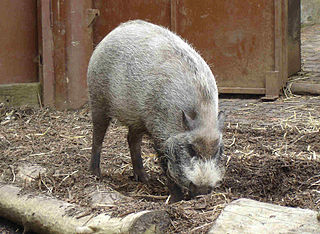
Physeteroidea is a superfamily that includes three extant species of whales: the sperm whale, in the genus Physeter, and the pygmy sperm whale and dwarf sperm whale, in the genus Kogia. In the past, these genera have sometimes been united in a single family, the Physeteridae, with the two Kogia species in the subfamily Kogiinae; however, recent practice is to allocate the genus Kogia to its own family, the Kogiidae, leaving the Physeteridae as a monotypic family, although additional fossil representatives of both families are known.

Trigonostylops is an extinct genus of South American meridiungulatan ungulate, from the Late Paleocene to Late Eocene of South America and Antarctica. It is the only member of the family Trigonostylopidae.

Suinae is a subfamily of artiodactyl mammals that includes several of the extant members of Suidae and their closest relatives – the domestic pig and related species, such as babirusas. Several extinct species within the Suidae are classified in subfamilies other than Suinae. However, the classification of the extinct members of the Suoidea – the larger group that includes the Suidae, the peccary family (Tayassuidae), and related extinct species – is controversial, and different classifications vary in the number of subfamilies within Suidae and their contents. Some classifications, such as the one proposed by paleontologist Jan van der Made in 2010, even exclude from Suinae some extant taxa of Suidae, placing these excluded taxa in other subfamilies.

Coline-Marie Orliac is a French harpist. A graduate of the Curtis Institute of Music, she has performed with leading orchestras including the Berlin Philharmonic.
The South American land mammal ages (SALMA) establish a geologic timescale for prehistoric South American fauna beginning 64.5 Ma during the Paleocene and continuing through to the Late Pleistocene. These periods are referred to as ages, stages, or intervals and were established using geographic place names where fossil materials where obtained.
The Mayoan age is a period of geologic time from 11.8 to 10 Ma, within the Middle to Late Miocene epoch of the Neogene, used more specifically within the SALMA classification in South America. It follows the Laventan and precedes the Chasicoan age.
The Huayquerian age is a period of geologic time within the Late Miocene epoch of the Neogene, used more specifically within the SALMA classification. It follows the Chasicoan and precedes the Montehermosan age.

Ceratotherium neumayri is a fossil species of rhinoceros from the Late Miocene (Vallesian-Turolian) of the Balkans and Western Asia, with remains known from Greece, Bulgaria, Iran, and Anatolia in Turkey.

Morotopithecus is a genus of fossil ape discovered in Miocene-age deposits of Moroto, Uganda.

Cetotheriidae is a family of baleen whales. The family is known to have existed from the Late Oligocene to the Early Pleistocene before going extinct. Although some phylogenetic studies conducted by Fordyce & Marx 2013 recovered the living pygmy right whale as a member of Cetotheriidae, making the pygmy right whale the only living cetotheriid, other authors either dispute this placement or recover Neobalaenidae as a sister group to Cetotheriidae.

Cainotheriidae is an extinct family of artiodactyls known from the Late Eocene to Middle Miocene of Europe. They are mostly found preserved in karstic deposits.

The Pebas Formation is a lithostratigraphic unit of Miocene age, found in western Amazonia. The formation extends over 1,000,000 square kilometres (390,000 sq mi), including parts of Brazil, Peru, Ecuador and Colombia. It is interpreted as representing the deposits of a lake or series of lakes, formed within the foreland basin of the Andes mountain belt. It is known for its abundant fossil ostracods and molluscs and an unusually diverse group of crocodylians.

Hyotheriinae was a subfamily of even-toed ungulates that existed during the Miocene and Pliocene in Europe, Asia, and Africa.
Eurolistriodon was an extinct genus of even-toed ungulates that existed during the Miocene in Europe.

Miocochilius is an extinct genus of small notoungulate mammals (typotheres) native to South America. The genus lived during the Middle Miocene epoch. The genus contains two described species, the type species M. anomopodus described in 1953 by Ruben Arthur Stirton and M. federicoi, described and included in the genus by Darin A. Croft.
Canaanimico is an extinct genus of medium-sized New World monkeys from the Late Oligocene fossiliferous fluvio-lacustrine Chambira Formation of the Ucayali Basin in Amazonian Peru. The genus was described by Marivaux et al. in 2016 and the type species is C. amazonensis.
Idiophyseter is a genus of macroraptorial sperm whale from the Miocene. Its fossils have been found in Templeton California. Idiophyseter was small in size compared to modern genera and its maxilla has single-rooted alveoli. It lacked ventral internal process of the sort present in the modern day genus of sperm whale (Physeter).

Nyanzapithecus pickfordi is an extinct species of primate from the Middle Miocene of Maboko Island, Nyanza Province, Kenya. It had an average body mass of around 10 kg (22 lb).

Ancodonta is an infraorder of artiodactyl ungulates including modern hippopotamus and all mammals closer to hippos than to cetaceans (whales). Ancodonts first appeared in the Middle Eocene, with some of the earliest representatives found in fossil deposits in Southeast Asia. Throughout their evolutionary history they have occupied different browsing and grazing niches in North America, Eurasia and Africa. The last continent is notable as they were among the first laurasiatherian mammals to have migrated to Africa from Europe, where they competed with the native afrothere herbivores for the same niches. Of the nearly 50 genera that have existed, only two of them are extant – Choeropsis and Hippopotamus. The interrelationships within the ancodonts has been contended. The traditional notion is that there at minimum two families Anthracotheriidae and Hippopotamidae and were merely sister taxa. However many detailed research of the dentition among ancodonts, as well as how some anthracotheres were similar to hippos in appearance, lead the current consensus where Anthracotheriidae is paraphyletic to Hippopotamidae. Among the anthracotheres, members of Bothriodontinae are among the closest to the ancestry of hippos, with the Oligocene aged Epirigenys from Lokon, Turkana, Kenya being the sister taxon to hippos. In response of this many similar clade names have been used for this clade.













